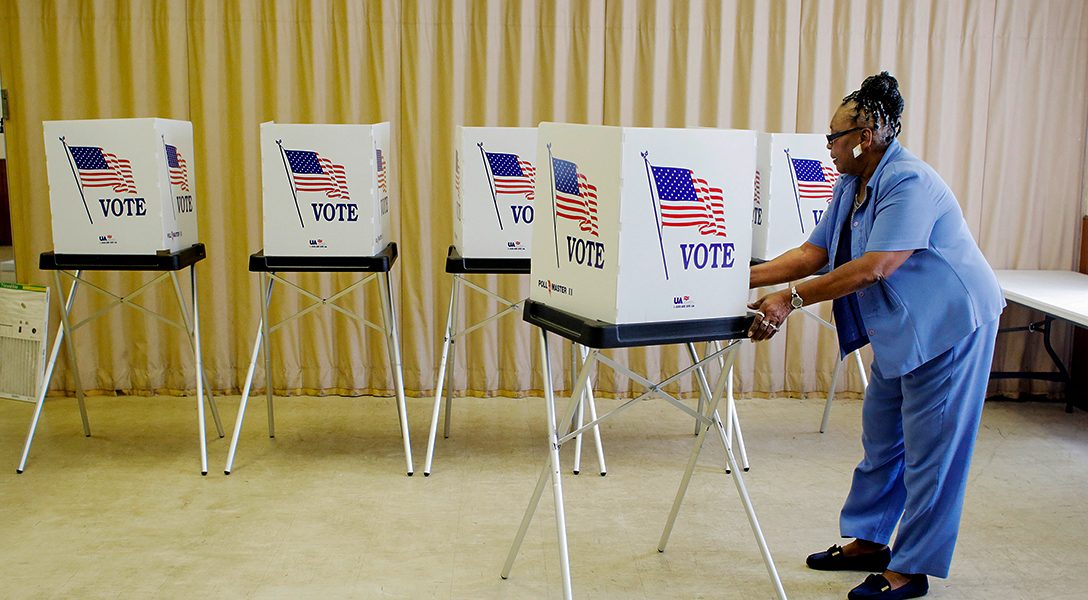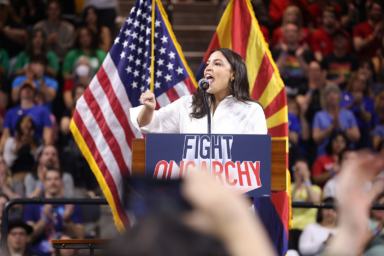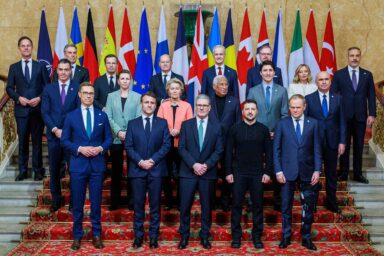Voter Suppression 101
How State Governments Legally Damage Democracy
A look at how voting laws are being subverted to suppress minority participation, and at the resultant degradation of democracy.
While widespread voter fraud may be a figment of President Donald Trump’s imagination, it should never be confused with voter suppression, which is very real. Two months out from the midterm elections, the basic rights of millions of Americans are under threat.
In this week’s WhoWhatWhy podcast, Jeff Schechtman is joined by Carol Anderson, the Chair of African American studies at Emory University and an authority on voter suppression — especially of the efforts to disenfranchise African American voters in the South.
She talks about how individuals within state governments are relentlessly fighting to deprive citizens of their fundamental rights. She explains how this is part of the long legacy of structural racism, which has become even more pernicious since the 2013 Supreme Court decision in Shelby County v. Holder. That ruling eviscerated, in her opinion, the Voting Rights Act of 1965, by allowing states and communities with a demonstrated history of racial discrimination to change voting requirements without approval from the Department of Justice.
Anderson shares with Schechtman several case histories about states that have adopted voter suppression tactics, including photo ID requirements, poll closures, and voter-roll purging. She explains how they all work and how they can be combated.
Citing the recent victory of Sen. Doug Jones (D-AL), she details how dedicated organizations and individuals were able to overcome almost every tactic of voter suppression and she talks about how this could be a template for the 2018 midterms.
This conversation with Carol Anderson — in which she draws from her book One Person, No Vote — is Voter Suppression 101: a fundamental primer on its reasons, its techniques, and the ways that it can and should be fought.
This article has been updated.
Click HERE to Download Mp3
Full Text Transcript:
As a service to our readers, we provide transcripts with our podcasts. We try to ensure that these transcripts do not include errors. However, due to time constraints, we are not always able to proofread them as closely as we would like. Should you spot any errors, we’d be grateful if you would notify us.
| Jeff Schechtman: | Welcome to Radio WhoWhatWhy. I’m Jeff Schechtman. Just a couple of weeks ago, I interviewed a distinguished and respected journalist and author, who said that voter suppression to him was like the Loch Ness Monster. A lot of people talked about it, but no one had ever really seen it. I tell this story because I’m afraid that his attitude is far too prevalent, and his confusion between voter fraud and voter suppression all too common. |
| While widespread voter fraud may be a fragment of Kris Kobach and Donald Trump’s imagination, it should never be conflated with voter suppression, which is very real, anti-democratic and infused with a degree of racism that particularly, since a 2003 Supreme Court decision, has become almost the regular order of things in multiple parts of the country. As we sit two months out from the midterm elections, the basic right of millions of Americans are under threat, at precisely the time when the future of the country is at stake as never before. This is particularly true in states with high profile races like Georgia and Florida, where voter suppression may truly affect the outcome. | |
| We’re going to talk about this today with my guest, Carol Anderson. Carol Anderson is the Charles Howard Candler professor and chair of African-American Studies at Emory University. She’s the author of the previously best-selling book, White Rage, which also won the National Book Critic’s Circle Award. She was a Guggenheim Fellow for constitutional studies, and she’s recently authored, One Person, No Vote: How Voter Suppression Is Destroying our Democracy. Carol Anderson, thanks so much for joining us here on Radio WhoWhatWhy. | |
| Carol Anderson: | Oh, thank you so much for having me, Jeff. |
| Jeff Schechtman: | I want to talk first about this confusion a lot of people have about voter fraud and voter suppression, that they really are two very different things. I’m surprised at how many people confuse them. |
| Carol Anderson: | I think that part of the problem is that first you get, frankly, the smoke and mirrors of voter fraud. We’ve heard that mantra over and over and over again so it almost sounds like the truth. When you go looking for it, it’s just not there. It is the Loch Ness monster. What happens then is that politicians, particularly the Republicans, have used the language of voter fraud, the fear of voter fraud, the warning signs that our democracy is under siege and imperiled by voter fraud, to then justify voter suppression. Why voter suppression doesn’t ping up and why we can’t see it as readily is because the ways that it’s implemented are very bureaucratic, very subtle, but very devastating. |
| I’ve got to say the other thing is that it looks like our system works. We see polls going through. We see debates between the candidates. We see people going to the polls and casting a vote. We see election results on that night, and then we have a winner declared. We have the kind of illusion that the system is working, but if we look behind the curtain, we’ll see the little Wizard of Oz pulling the levers, giving the appearance of something functioning, when in fact what is going on is that we have systematically, via our laws, cut out millions of people from their basic right to vote. | |
| Jeff Schechtman: | One of the things that has contributed to this in the past few years, and you spend a great deal of time focusing on this in “One Person, No Vote”, is this Shelby decision, this Supreme Court decision from 2013. Talk about that. |
| Carol Anderson: | Yes. To understand Shelby, I think part of what we have to understand is that it came in the wake of Barack Obama’s elections. One of the things that we often hear, for instance, is that how racist can this nation be? We elected a Black man twice to the White House. People pat themselves on the back. In fact, it was since 1964, the majority of Whites, and ’64 is key because that’s when LBJ signed the Civil Rights Act of 1964. In ’65 we get the Voting Rights Act. Since then the majority of Whites have not voted for a Democratic candidate for president since 1964. The coalition that put Obama in the White House, that voted Obama in the White House is one where he brought 15 million new voters to the polls, primarily African-American, Latino, Asian-American, the youth and those who make below $15,000 a year. That was the coalition that he brought in, that put him in power. |
| The Shelby County v. Holder decision basically gutted the Voting Rights Act. The way that it did that was to … Chief Justice John Roberts said, “You know, racism really isn’t like it was in the era of Jim Crow. It’s not like it was in the 60s or in the 1890s. Those days are over. This Act is stagnant. Many of the jurisdictions that were placed under its domain in 1965 have remained there. Only 17 have bailed out. Clearly there’s something wrong with the Act. What this Act is doing,” he said, “is picking on the South.” Now I counter that the reason why so few have bailed out is because so few have stopped discriminating against their minority populations at the ballot box, trying to figure out ways, how to wiggle around, how to keep African-Americans and Latinos and Asian-Americans from voting. That didn’t seem to cost John Roberts or the other four justices in that 5-4 decision. | |
| The Voting Rights Act had provided the shield where states that had had a history of discriminating against these minority populations at the ballot box. States that had used a method to ensure limited access to the ballot box, such as a poll tax or a literacy test, those states had come under what they called the pre-clearance provision of the Voting Rights Act. Whenever they changed any of the laws dealing with voting rights, they had to have that change okayed by the US Department of Justice or by the Federal Court in DC. Without the protection of the Voting Rights Act, these states, boom, went for it, making all kinds of changes now that they didn’t have to have them pre-cleared, and these changes were targeted at the very groups that had put Obama in the White House. | |
| Jeff Schechtman: | Talk a little bit about what some of those specific changes are. We hear a lot about photo ID, voter ID, but there’s also a whole panoply of changes. |
| Carol Anderson: | Yes. I’ll start first with voter ID, because that seems to be the one where you get the language about voter fraud. What that one did was … it sounds innocuous. This is part of why it seems invisible or non-existent. It sounds innocuous. All you need to do is show your ID to prove who you are to vote. But it’s not just any ID. These legislatures, such as the one in North Carolina, received data about what types of government issued photo IDs African-Americans had and didn’t have. Which were the ones that Whites had in a preponderance vis-a-vis the number that African-Americans had? Then that legislature wrote into the law to privilege the kinds of IDs that Whites had. |
| You take a place like Alabama. In 2011, before the Shelby County v. Holder decision even, Alabama passed a voter ID law. It didn’t implement it at the time because they knew it couldn’t get past the Department of Justice pre-clearance review. After Shelby County v. Holder, Alabama did implement that law. That law said you must have a government-issued photo ID, it identified which types of government-issued photo ID would be acceptable, and it decided that public housing ID would not count. | |
| Now, Alabama’s a poor state. It has a lot of people in public housing, 71% of whom are African-American. Therefore, to say that public housing ID does not count, means that they’re automatically X-ing out that population from being able to access the ballot box. To double down on that, then the governor of Alabama shut down the Department of Motor Vehicles in the Black belt counties, which would require, then, residents of those counties to go about 50 miles to get an ID. If you don’t drive and there’s no public transportation, how do you get 50 miles to get an ID? That’s part of the chicanery behind the photo ID, government-issued photo ID. | |
| One of the other things that they do is voter roll purges. Voter roll purges came out of a law, the National Voter Registration Act, which was designed to open up registration by saying that, you know, if you’re at a Department of Motor Vehicles, you can register to vote there. You don’t have to go downtown to the Board of Elections, for instance, because Congress was concerned that in the 1988 election voter turnout was the lowest it had been since 1924. But the Republicans put a clause in there that dealt with voter roll maintenance. Again, it sounds innocuous enough. Yeah, we need to make sure that people who have died are no longer on the voting rolls. People who have moved out of the jurisdiction are no longer on the voting roll. Again, it sounds reasonable, but what these secretaries of state have done is to use that language of voter roll maintenance to give the aura that they’re doing their job, while in fact what they’re doing is they’re removing millions of American citizens off of the voting rolls simply because they have not voted regularly in a federal election. | |
| Then there’s gerrymandering. What gerrymandering does … Let me back up. The constitution requires that after the census is taken, that a legislative body aligns and draws the districts to deal with the population shifts that have happened over the past decade. That sounds, again, innocuous, but what the Republicans did was to … We’ve had gerrymandering for a long time. Let me be really clear about that. They have just taken it to an extreme level. They use this powerful computer software mapping program. They bring in the kind of Cambridge Analytics data about who lives where so they can figure out what their political proclivities might be. Then they start drawing the maps to dilute the power, the voting power, to dilute the very instance of one person, one vote. | |
| What we had in Wisconsin, which is a case of extreme partisan gerrymandering, after the maps were drawn, Democratic candidates for the state legislature received 52% of the vote, and they received 39% of the seats in the state legislature. It got worse with each subsequent election, so that the voting power of Democrats is absolutely diluted, and the voting power of Republicans is amplified, with these extreme gerrymandered maps. They create these safe districts so that you don’t have the kind of representation … For instance, we were trying to figure out, during when Congress was trying to gut the Affordable Care Act, but you’re seeing 70% of Americans really want the Affordable Care Act. They want to see it improved, not gutted, but Congress was barreling down that path to dismantle Obamacare, access to health insurance. It looked like this weird juxtaposition. How are you getting 70% of Americans really valuing this and how are you getting the majority of Republicans going against this? It’s because of these gerrymandered districts that create these safe districts where they don’t have to be responsive to the needs of their constituency. | |
| Jeff Schechtman: | One of the things we’ve seen, though, is the courts have stepped in in some of these more egregious cases, North Carolina and Wisconsin perhaps being the penultimate examples here, to really deal with at least the gerrymandering part of this. |
| Carol Anderson: | The courts have stepped in. You know, there are times where you’re just like, “Thank God for the federal courts.” Frankly, what is scary, what we have to pay attention to, is how the current Senate is rushing through a slate of federal judges, these justices that have been nominated by Donald Trump onto the federal bench, because McConnell had held off on moving through many of Obama’s nominations for the federal bench. There were all of these holes. Now they’re being filled with Trump appointees who are very clearly, looking at their track record, anti-voting rights. How long this federal bulwark can hold is not clear. |
| Jeff Schechtman: | One of the places you mentioned where a lot of this suppression has been going on for a long time is in Alabama. Yet there was a significant Black turnout in Alabama that helped elect Doug Jones. Talk a little bit about that, how it played out and the degree to which the problem is getting better or worse there. |
| Carol Anderson: | As you know, that election in Alabama is in my chapter called ‘The Resistance’, because the state of Alabama deployed every method of voter suppression. You know, not only the voter IDs, not only the gerrymandered districts and what we know about gerrymandering is that it’s designed also to demoralize a population, because you feel like your vote doesn’t count because the system is rigged. It brings about lower voter turnout. Alabama had also done voter roll purges, had also moved polling places, shut down 66 polling places. The research is clear. For every half mile, quarter mile that a polling place is moved, the Black voter turnout rate goes down, the further away the polling place is from the African-American community. Alabama had shut down 66 polling places. |
| You also had massive disfranchisement due to felony convictions. In 1901, when Alabama wrote its Jim Crow constitution, it had a clause in there that if you have been convicted of a crime of moral turpitude, you have lost your voting rights. If you tried to vote after that, it is a felony and you could go back to prison. That was 1901. Alabama refused to define moral turpitude. The result of that was that 8% of its population was disfranchised, and 15% of African-American voters disfranchised. | |
| This is where I just started doing the dance of joy. Civil society stepped in and did the heavy lifting of democracy. Groups like the NAACP, the Legal Defense Fund, the ACLU, the League of Women Voters started pounding on Alabama, for instance, on the moral turpitude clause, taking back to court and back to court and back to court until finally Alabama relented, and in 2017 defined the crimes that count as moral turpitude, like murder, rape, treason. Then those organizations turned to Secretary of State, John Merrill, and said, “Great. Now tell all of the folks that you told that they couldn’t vote, now tell them that this new law means that they can.” John Merrill said, “I don’t think that’s a really good use of state resources.” | |
| These organizations, the Legal Society of Alabama, as well as the ACLU of Alabama, began to send out the word via radio as well as social media, that if you have a felony conviction, you actually might be able to vote. Come to these restoration clinics that we’ve set up and let’s find out. Through a massive publicity campaign and then these restoration clinics which were held, many in the Black churches, you had a team of lawyers and volunteers going through people’s records and saying, “Nope, that’s not moral turpitude. Nope, that’s not moral turpitude. Wow. Yes, you can vote.” | |
| Then the next phase was to have them to figure out what they needed to do in order to be able to register to vote and get them registered. Another group, the Ordinary People Society, went into the jails, because Alabama had on the books that those who were incarcerated could vote absentee ballot. Now of course if you don’t know whether moral turpitude counts for you or not, you’re hesitant to vote. Now that it had been defined, the group went into the jails, also going through people’s records, then getting them registered to vote, and then providing them with absentee ballots. | |
| You had another group. The NAACP did a fabulous job in terms of finding out who didn’t vote in 2016, or who had been voting sporadically, and began calling them, sharing that information with indivisible, so that they were calling and then following up by knocking on doors and talking to their neighbors about what was at stake, what were the issues that really resonated, that meant the most to the people who hadn’t voted yet. What was coming out, of course, access to health care, quality education, jobs with a living wage, criminal justice reform, and then the volunteers, the organizers were laying out how each of those could be affected by who was going to be elected. Then registering people to vote. They understood that voting is a social function, and so they were also going to class reunions with packets of information about how do you register to vote and where do you register to vote and what’s the deadline for registering to vote. | |
| One of the other pieces that I love … there are a couple of other pieces. One was given that the polls had been closed, they worked out a private car system, kind of like in the Montgomery bus boycott of 1955, that would transport voters from their homes to the polls and back, because the distance to the polls was one of the key barriers to accessing the right to vote. They also had the Lawyer’s Committee for Civil Rights, had a team of lawyers stationed in key polling precincts to ensure that the right to vote was fully, what do you call it, was fully adhered to. One of the things that came out, for example, was that when those who had been previously convicted went to vote, they brought their mug shots and some poll workers weren’t accepting them. It had been worked out that in fact mug shots were a government-issued photo ID, so being able to clarify that on the spot right there allowed those people to be able to vote and to really begin that full civic engagement again. | |
| It was a thing of beauty what civil society did. They talked with each other. They shared information. They coordinated. You also had money pouring in from outside of Alabama, but that outside money understood that the folks in Alabama who were there on the ground knew best how to deploy and use those resources. The result was John Merrill believed that the voter turnout rate in that election would be 25%. In fact it was 40%, but in the Black belt counties where Alabama had seriously deployed every voter suppression method out there, it was 45%. That was basically the window of victory to defeat Roy Moore. | |
| Jeff Schechtman: | Among all of these methods that you’ve been talking about, one that we don’t hear as much about, but it did come up at various times in the 2016 campaign, was this whole idea of voter intimidation. Talk about that. |
| Carol Anderson: | Yeah. Voter intimidation, and that’s some old school Jim Crow right there. |
| Jeff Schechtman: | Right. |
| Carol Anderson: | Back in the Jim Crow days, what would happen is that the sheriff would be right there at the polling place. The relationship between law enforcement and the Black community is not a good one because law enforcement would use its power to intimidate, to beat … I mean the sheriff used to brag about beating Black people who tried to vote. That is a memory, that is a history, that is a legacy. Voter intimidation is like what happened in the 2000 election, where in Florida, in Jacksonville, the Florida highway patrol set up check points at the only road going into the voting precinct in Black neighborhoods. |
| Carol Anderson: | As you’re coming up to go vote, all of a sudden you have to go through a check point with police officers who are questioning who you are, trying to figure out if you’ve got a warrant, you know just the kind of intimidation that means, “Do you know what? I’m not going to deal with this. I’m not going to deal with this.” Let’s face it. That was relying upon that memory, relying upon that history, is also then where you have Donald Trump, when he is in Pennsylvania, talking about sending up his team to poll watch in Philadelphia. That is not even a dog whistle. That is a bark because one of the key ways of defining voter fraud is to align it with urban areas, which then becomes code for African-Americans. Saying Philadelphia is a way of saying, “This is where the problem is.” |
| Before that, you had the folks, True the Vote, who would go into polls and challenge people, saying, “I don’t believe you’re supposed to be here. You’re not a citizen,” or, “You’re not registered here on the polls right, so you’re not supposed to be voting here.” That kind of harassment is also part and parcel of voter suppression. It’s not supposed to happen, but it does. | |
| Jeff Schechtman: | How do you see all of this playing out in the 2018 elections from what you’re seeing both nationally, but more specifically, in some of the high profile races that we’re looking at in places like Georgia and Florida? |
| Carol Anderson: | What I see happening is civil society and in fact many citizens are now on alert. I take, for instance, the example of Randolph County, Georgia. What happened there was … Let me back up. What happened there was that a consultant who was an ally of Brian Kemp, who is our secretary of state and now the Republican running for governor, had recommended in Randolph County, that is over 60% Black- |
| Jeff Schechtman: | This is in Georgia, for our listeners. We’re talking about Georgia here. |
| Carol Anderson: | Georgia. Yes. Randolph County in Georgia had recommended that … wait a minute. Let me back up. Over 60% of Randolph County is African-American. He had recommended that seven of the nine polling places be shut down before the general election. Now he used the excuse that they were not ADA compliant, but the issue of ADA compliance was not there during the primary when Brian Kemp was running, nor was it there during the GOP runoff between Brian Kemp and Casey Cagle. It reared its head when it became clear that Kemp was going to be running against Stacey Abrams, an African-American woman. When you began to look at where his consultant had designated most of the polls to be closed, there were 10 counties in Georgia. Of those ten counties, all had sizeable Black populations. |
| Civil society was watching and began spreading the word about what these recommendations were designed to do and how they were designed to force many Randolph County residents to go 10 miles to be able to vote. They flooded social media. They flooded traditional media, and they packed the Board of Elections meeting, where that proposal was being voted upon, and they shut it down. It’s that kind of, frankly, eternal vigilance. This election is requiring that level of eternal vigilance. | |
| We see in Texas, where … Texas also has a strict voter ID law. Texas tried to close over 200 Departments of Motor Vehicles where people could get their licenses. With Texas trying to close over 200 of these, and they already had one third of their counties without a Department of Motor Vehicles when they passed SB14, their voter ID law that was going to require people to make a 250 mile round trip to get a license, but you don’t drive. This was massive voter suppression again, because it wasn’t like they were offering a viable alternative. Remember, there is a close election happening in Texas right now that looks it can unseat sitting Senator Ted Cruz. You’re seeing all of these methods being deployed because the Republicans are almost, the population is about 90% White. Their platform cannot speak to a broader diverse America. It could, but they’ve made a choice for it not to and to speak in fact to the base. By speaking to the base, they have then become very repugnant to many Americans. | |
| There was a recent poll where millennials, African-American, Latino, and Asian-American millennials, and White millennials, all said that the Republican party just did not address any of their concerns. The response then was how do you win these elections if our policies don’t bring in the voters? The way they’re doing it is via voter suppression. | |
| Jeff Schechtman: | Do you see this trend continuing? |
| Carol Anderson: | I see that they will fight tooth and nail for voter suppression. I say that because it would seem, for instance, that after a federal court says, “This has a discriminatory impact,” that the state would go back going, “Oops, sorry. Didn’t mean that,” and then draft a law that was clean. That’s not what Texas did. That’s not what North Carolina did. That’s not what Wisconsin did. Instead they went back and tried to finesse it so that they could push it through again to have the same disparate impact on minority voters, and having to go back to the court over and over and over and over. Now, for instance, we’re looking at North Carolina, that the court has said, “Your gerrymandered districts are racially discriminatory.” North Carolina’s response is, “Yeah, but it’s too close to the election to re-draw them, so why don’t we just keep them?” |
| That is part of the way that this thing works. Imagine holding yet another election with racially discriminatory boundaries to create a racially discriminatory state legislature. It’s going to require our eternal vigilance. It’s going to require that we vote. I mean we have got to turn out and vote. Again, I look at those folks in Alabama, where Alabama did everything possible to keep them from the polls. They turned out in record numbers, higher than the state average. That’s what we’re going to have to do if we’re going to be able to then put in place policy makers who really value and believe in democracy and are trying to figure out how do we include more American citizens in this democracy, than rather exclude them? | |
| Jeff Schechtman: | Carol Anderson. Her book is, One Person, No Vote: How Voter Suppression is Destroying our Democracy. Carol, I thank you so much for spending time with us today here on Radio WhoWhatWhy. |
| Carol Anderson: | Thank you so much, Jeff. |
| Jeff Schechtman: | Thank you. And thank you for listening and for joining us here on Radio WhoWhatWhy. I hope you join us next week for another Radio WhoWhatWhy podcast. I’m Jeff Schechtman. If you liked this podcast, please feel free to share and help others find it by rating and reviewing it on iTunes. You can also support this podcast and all the work we do by going to whowhatwhy.org/donate. |
Related front page panorama photo credit: Adapted by WhoWhatWhy from protesters (Michael Fleshman / Flickr – CC BY-SA 2.0) and One Person, No Vote (Bloomsbury Publishing).






